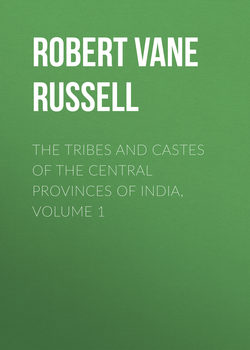Читать книгу The Tribes and Castes of the Central Provinces of India, Volume 1 - Robert Vane Russell - Страница 24
Part I.
Introductory Essay on Caste
Introductory Essay on Caste
21. Status of the cultivator
ОглавлениеThe above details have been given to show how the different agricultural castes originated. Though their origin is so diverse they have, to a great extent, the same status, and it seems clear that this status is dependent on their possession of the land. In the tracts where they reside they are commonly village proprietors and superior tenants. Those who rank a little higher than the others, as the Jāts, Marāthas, Dāngis and Lodhis, include in their body some ruling chiefs or large landed proprietors, and as a rule were formerly dominant in the territory in which they are found. In primitive agricultural communities the land is the principal, if not almost the sole, source of wealth. Trade in the modern sense scarcely exists, and what interchange of commodities there is affects, as a rule, only a trifling fraction of the population. India’s foreign trade is mainly the growth of the last century, and the great bulk of the exports are of agricultural produce, yet in proportion to the population the trading community is still extremely small. It thus seems quite impossible that the Aryans could have been a community of priests, rulers and traders, because such a community would not have had means of subsistence. And if the whole production and control of the wealth and food of the community had been in the hands of the Sūdras, they could not have been kept permanently in their subject, degraded position. The flocks and herds and the land, which constituted the wealth of early India, must thus have been in the possession of the Vaishyas; and grounds of general probability, as well as the direct evidence already produced, make it clear that they were the herdsmen and cultivators, and the Sūdras the labourers. The status of the modern cultivators seems to correspond to that of the Vaishyas, that is, of the main body of the Aryan people, who were pure and permitted to join in sacrifices. The status, however, no longer attaches to origin, but to the possession of the land; it is that of a constituent member of the village community, corresponding to a citizen of the city states of Greece and Italy. The original Vaishyas have long disappeared; the Brāhmans themselves say that there are no Kshatriyas and no Vaishyas left, and this seems to be quite correct. But the modern good cultivating castes retain the status of the Vaishyas as the Rājpūts retain that of the Kshatriyas. The case of the Jāts and Gūjars supports this view. These two castes are almost certainly derived from Scythian nomad tribes, who entered India long after the Vedic Aryans. And there is good reason to suppose that a substantial proportion, if not the majority, of the existing Rājpūt clans were the leaders or aristocracy of the Jāts and Gūjars. Thus it is found that in the case of these later tribes the main body were shepherds and cultivators, and their descendants have the status of good cultivating castes at present, while the leaders became the Rājpūts, who have the status of the Kshatriyas; and it therefore seems a reasonable inference that the same had previously been the case with the Aryans themselves. It has been seen that the word Visha or Vaishya signified one of the people or a householder. The name Kunbi appears to have the same sense, its older form being kutumbika, which is a householder or one who has a family,51 a pater familias.
51
See article on Kunbi, para. 1.
